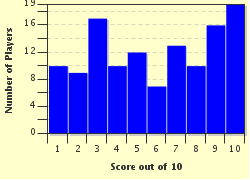Quiz Answer Key and Fun Facts
1. This Class 44 locomotive numbered D1 appeared at the very top of most classifications and/or listings of British Rail locomotives. What was its name?
2. The Class 45 locomotives were more powerful successors to the Class 44's. Some of these locomotives were named after soldiers of regiments of the British Army. Which one of these was NOT a Class 45 locomotive?
3. "Albion" , "Royal Oak", "Roebuck" and "Foxhound" were names of Class 42 locomotives. All the names of locomotives in this class shared a common theme, and as such they were given the nickname "Pubs".
4. 1965 was a year of ups and downs for this Class 47 Locomotive numbered D1671. In September it received the name of a mythological deity. In December of the same year it was involved in a collision with another train which led to it being the first "named" Class 47 to be scrapped. Which deity was on the nameplate?
5. The naming of D1662 at Bristol Temple Meads nicely tied together London's Paddington Station 100 miles to the east, and the Royal Albert Bridge spanning the Tamar at Plymouth, 100 miles to the south-west. What was the name given to D1662?
6. What are "Fearless", "Invincible", "Repulse" and "Warspite"?
7. Brush Electrical Engineering Ltd, who supplied many of the locomotives to British Rail from 1960 onwards, produced a single prototype of a diesel-electric locomotive for British Rail in 1961, which was designated the only member of "Class 53". The locomotive remained in use until 1973. What was its name?
8. In spite of British Rail spinning out the testing of D1200 for more than 14 years, in 1968 Brush provided another prototype, numbered HS4000, which was the world's most powerful single-diesel locomotive. What was the name of the HS4000?
9. All the locomotives belonging to Class 52 carried names, and without exception all the names started with the same word. What word was this?
10. The final question refers to the Class 55 "Deltics". One of these famous locomotives, D9002, is the first (in 1966) to receive the "BR Blue" livery. In 1979, the same locomotive, now numbered 55 002, is selected by the National Railway Museum to be preserved as part of the national collection. What is the name of this illustrious "Deltic"?
Source: Author
burbanksteve
This quiz was reviewed by FunTrivia editor
Bruyere before going online.
Any errors found in FunTrivia content are routinely corrected through our feedback system.

